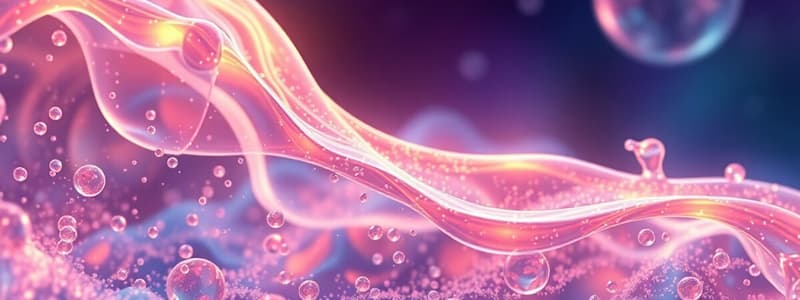Podcast
Questions and Answers
What is the primary advantage of using temperature-sensitive polymers in drug delivery systems?
What is the primary advantage of using temperature-sensitive polymers in drug delivery systems?
- They are less expensive to produce.
- They can respond to temperature changes to control drug release. (correct)
- They provide sustained release of medication.
- They are always biodegradable.
What defines Aggregation-Induced Emission (AIE) enhancement in fluorescent probes?
What defines Aggregation-Induced Emission (AIE) enhancement in fluorescent probes?
- All fluorescent materials exhibit AIE properties.
- Increased fluorescence when the molecules aggregate. (correct)
- Fluorescence that decreases when diluted.
- Emission spectra that shift into the infrared range.
Which feature is essential for biocompatibility in materials used for drug delivery?
Which feature is essential for biocompatibility in materials used for drug delivery?
- Material must be non-toxic and avoid adverse reactions in the body. (correct)
- Material should have a complex structure.
- Material needs to elicit a strong immune response.
- Material should be easy to manufacture in bulk.
What role do magnetic nanoparticles play in enhancing drug delivery systems?
What role do magnetic nanoparticles play in enhancing drug delivery systems?
Which of the following is an indicator of successful biocompatibility in a material?
Which of the following is an indicator of successful biocompatibility in a material?
Why is the exploration of biocompatible AIEgens important for drug delivery?
Why is the exploration of biocompatible AIEgens important for drug delivery?
What characteristic of thermoresponsive gels is pivotal for their application in medical therapies?
What characteristic of thermoresponsive gels is pivotal for their application in medical therapies?
What challenge does aggregation present in the use of fluorescent probes for bioimaging?
What challenge does aggregation present in the use of fluorescent probes for bioimaging?
What is the maximum loading efficiency of PA in the Cs-Cys-PN hydrogel?
What is the maximum loading efficiency of PA in the Cs-Cys-PN hydrogel?
At what temperature does the Cs-Cys-PN hydrogel show a significantly higher release of PA compared to 37 °C?
At what temperature does the Cs-Cys-PN hydrogel show a significantly higher release of PA compared to 37 °C?
What does the reversible phase transformation of PNIPAM in Cs-Cys-PN indicate about its potential applications?
What does the reversible phase transformation of PNIPAM in Cs-Cys-PN indicate about its potential applications?
What percentage of PA was released from the Cs-Cys-PN hydrogel at 24 hours under 37 °C?
What percentage of PA was released from the Cs-Cys-PN hydrogel at 24 hours under 37 °C?
How does Cs-Cys-PN/PA hydrogel perform under phosphate buffered saline (PBS) at 37 °C?
How does Cs-Cys-PN/PA hydrogel perform under phosphate buffered saline (PBS) at 37 °C?
What is the role of temperature in the fluorescence intensity of Cs-Cys-PN/PA?
What is the role of temperature in the fluorescence intensity of Cs-Cys-PN/PA?
What is essential for the biocompatibility of materials like Cs-Cys-PN?
What is essential for the biocompatibility of materials like Cs-Cys-PN?
Which of the following best describes the application of drug delivery systems like Cs-Cys-PN/PA?
Which of the following best describes the application of drug delivery systems like Cs-Cys-PN/PA?
What property does N-isopropylacrylamide (NIPAM) exhibit at different temperatures?
What property does N-isopropylacrylamide (NIPAM) exhibit at different temperatures?
What is the main purpose of using a dialysis tube with a MWCO of 3.5 KDa in the experiment?
What is the main purpose of using a dialysis tube with a MWCO of 3.5 KDa in the experiment?
How was the drug release percentage determined during the experiment?
How was the drug release percentage determined during the experiment?
What concentration range of Cs-Cys-PN was used in the cellular cytotoxicity study?
What concentration range of Cs-Cys-PN was used in the cellular cytotoxicity study?
Which chemical is typically used as a coupling agent in bio-conjugation experiments?
Which chemical is typically used as a coupling agent in bio-conjugation experiments?
What is a key characteristic of the fluorescent probes used for bioimaging?
What is a key characteristic of the fluorescent probes used for bioimaging?
Why is biocompatibility an essential requirement for materials used in drug delivery systems?
Why is biocompatibility an essential requirement for materials used in drug delivery systems?
What role does chitosan play in drug delivery systems?
What role does chitosan play in drug delivery systems?
Flashcards are hidden until you start studying
Study Notes
Chitosan-Cys-PNIPAM (Cs-Cys-PN) Hydrogel
- A novel thermoresponsive hydrogel based on N-isopropylacrylamide (NIPAM) is synthesized.
- The hydrogel is formed by co-polymerizing NIPAM with L-cysteine (Cys) in the presence of chitosan (Cs).
- Cs-Cys-PN exhibits a lower critical solution temperature (LCST) of 32 °C, transitioning from a hydrophilic to a hydrophobic state.
- The hydrogel's thermoresponsive behavior allows for controllable release of palmatine (PA), an alkaloid with therapeutic properties.
Synthesis and Characterization of Cs-Cys-PN
- NIPAM, Cys, and Cs are dissolved in acetic acid and then mixed.
- The solution is then polymerized using ammonium persulfate (APS) as an initiator.
- The resulting hydrogel (Cs-Cys-PN) is characterized using Fourier transform infrared spectroscopy (FTIR) and scanning electron microscopy (SEM).
Drug Loading and Release Studies
- PA loading efficiency in the Cs-Cys-PN hydrogel is high, reaching 96.8%.
- In vitro release studies at different temperatures (25 °C and 37 °C) reveal that PA release is significantly slower at 37 °C.
- The hydrogel efficiently retains PA at body temperature (37 °C), indicating potential for controlled drug delivery.
Cytotoxicity Studies
- Cs-Cys-PN shows good biocompatibility with Hela cells at concentrations up to 100 μg/mL.
- The hydrogel does not exhibit significant cytotoxicity, indicating its potential safety for biomedical applications.
Potential Applications of Cs-Cys-PN
- Cs-Cys-PN's ability to control drug release, coupled with its biocompatibility, makes it a promising candidate for various biomedical applications:
- Controlled drug delivery systems.
- Tissue engineering scaffolds.
- Bioimaging agents.
Studying That Suits You
Use AI to generate personalized quizzes and flashcards to suit your learning preferences.
